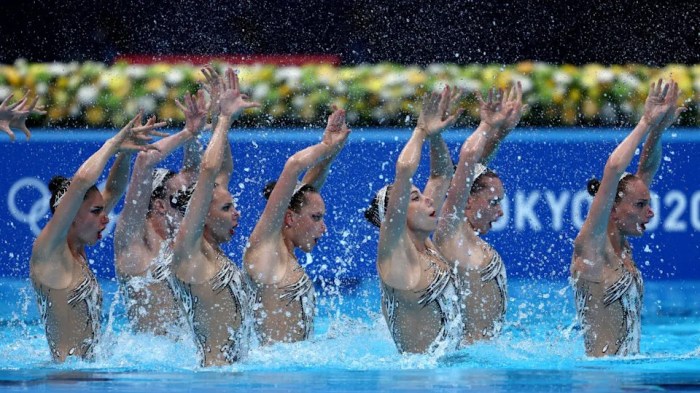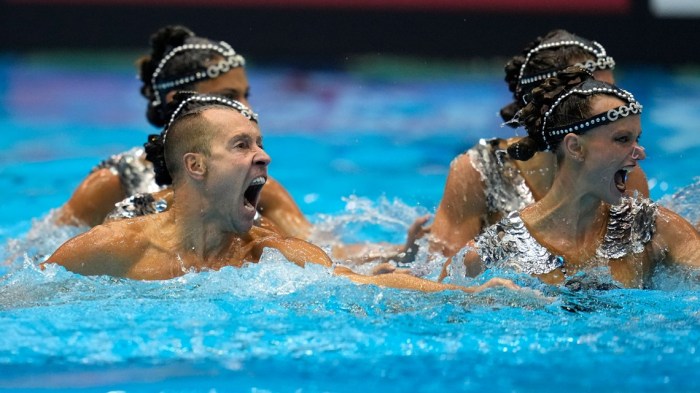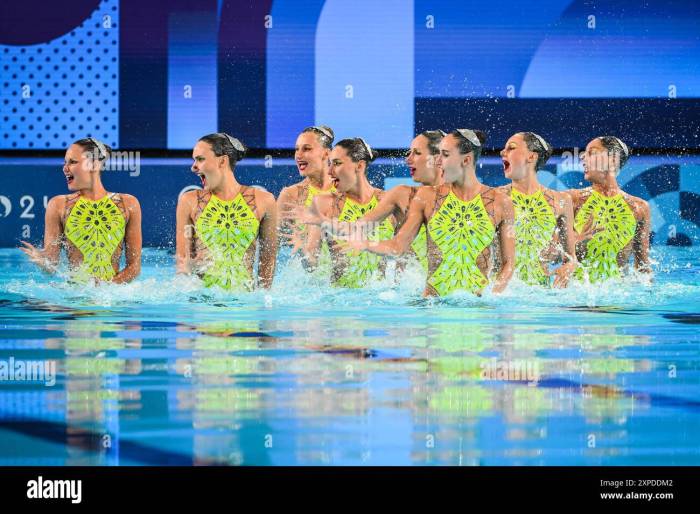Artistic swimming olympics winners – Artistic swimming, a mesmerizing blend of athleticism and artistry, has captivated audiences at the Olympics for decades. From the first medals awarded in 1984 to the present day, these extraordinary athletes have pushed the boundaries of human movement, showcasing unparalleled skill, teamwork, and grace.
In this captivating journey, we delve into the historical evolution of artistic swimming in the Olympics, celebrating the triumphs of winning teams and athletes. We explore the intricate techniques and skills that define this demanding sport, unraveling the criteria used to judge their performances.
Historical Evolution of Artistic Swimming in the Olympics

Artistic swimming, formerly known as synchronized swimming, has a rich history as an Olympic sport. It first appeared as a demonstration sport at the 1952 Helsinki Olympics, and became an official medal event for women at the 1984 Los Angeles Olympics.
Over the years, artistic swimming has undergone significant rule changes and developments. In the early days, the sport focused primarily on synchronized swimming and precision movements. However, in recent years, there has been a greater emphasis on artistic expression and athleticism.
Artistic swimming has gained popularity and recognition worldwide, with many countries now competing at the highest level. The sport has been praised for its beauty, grace, and athleticism, and it continues to captivate audiences around the world.
Winning Teams and Athletes

| Year | Team/Athlete | Country | Medal |
|---|---|---|---|
| 1984 | United States | USA | Gold |
| 1988 | Canada | CAN | Gold |
| 1992 | United States | USA | Gold |
| 1996 | United States | USA | Gold |
| 2000 | Russia | RUS | Gold |
| 2004 | Russia | RUS | Gold |
| 2008 | Russia | RUS | Gold |
| 2012 | Russia | RUS | Gold |
| 2016 | Russia | RUS | Gold |
| 2020 | Russian Olympic Committee | ROC | Gold |
The United States and Russia have been the most successful nations in artistic swimming at the Olympics, with the United States winning a total of three gold medals and Russia winning a total of five gold medals.
Some of the most notable athletes in artistic swimming history include Esther Williams, who was a pioneer of the sport in the 1940s and 1950s, and Natalia Ishchenko, who won six Olympic medals for Russia from 2004 to 2016.
Artistic Swimming Techniques and Skills

Artistic swimming requires a combination of strength, flexibility, endurance, and coordination. Athletes must be able to perform a variety of techniques and skills, including:
- Lifts: Athletes lift each other out of the water and hold them in various positions.
- Throws: Athletes throw each other into the air and catch them.
- Spins: Athletes spin around on their own axis.
- Flips: Athletes flip through the air.
- Twists: Athletes twist their bodies while in the air.
Teamwork, synchronization, and musicality are also essential elements of artistic swimming. Athletes must work together seamlessly to create a visually appealing and technically difficult performance.
Judging and Scoring in Artistic Swimming
Artistic swimming competitions are judged by a panel of judges who evaluate the athletes’ performance based on the following criteria:
- Technical merit: This includes the execution of the technical elements, such as lifts, throws, and spins.
- Artistic impression: This includes the overall presentation of the routine, including the choreography, music, and costumes.
Each judge scores the routine on a scale of 0 to 10, with 10 being the highest score. The final score is the average of the judges’ scores.
The judging system in artistic swimming has been the subject of some controversy over the years, with some critics arguing that it is too subjective. However, the system has been revised in recent years to make it more objective and fair.
Future of Artistic Swimming
Artistic swimming is a rapidly growing sport, with new countries competing at the highest level every year. The sport is also becoming more popular with spectators, as it offers a unique combination of athleticism, artistry, and entertainment.
In the future, artistic swimming is likely to continue to grow in popularity and recognition. The sport has the potential to become one of the most popular Olympic sports in the world.
To promote and grow artistic swimming at the international level, it is important to continue to develop the sport and make it more accessible to athletes and spectators around the world.
Conclusion
As we look towards the future of artistic swimming, we envision a sport that continues to inspire and enchant. With its growing popularity and the unwavering dedication of its athletes, artistic swimming promises to remain a vibrant and unforgettable spectacle at the Olympic Games.
Essential FAQs: Artistic Swimming Olympics Winners
Who are the most decorated artistic swimming teams in Olympic history?
The United States and Russia have dominated the sport, with the US winning the most medals overall and Russia claiming the most gold medals.
What are the key elements of artistic swimming?
Artistic swimming combines swimming, acrobatics, and dance, with athletes performing synchronized movements to music.
How are artistic swimming competitions judged?
Judges evaluate performances based on technical merit, artistic impression, and synchronization.